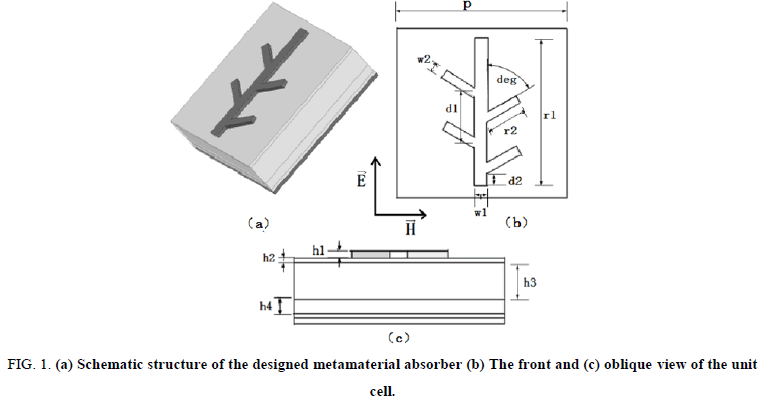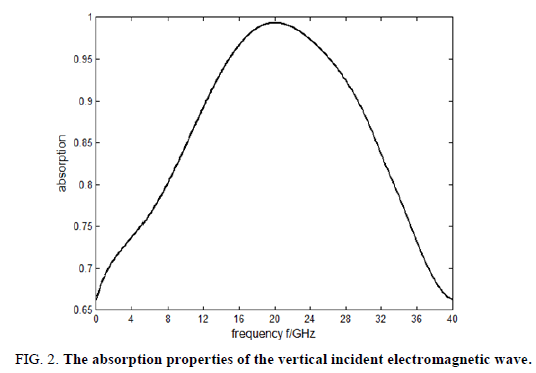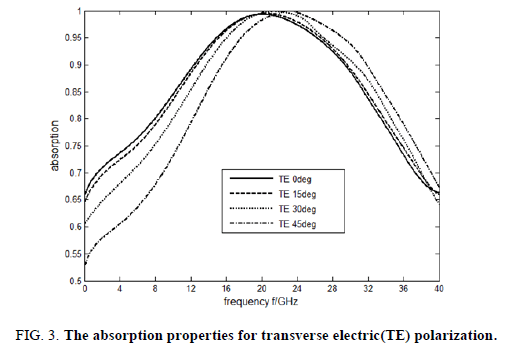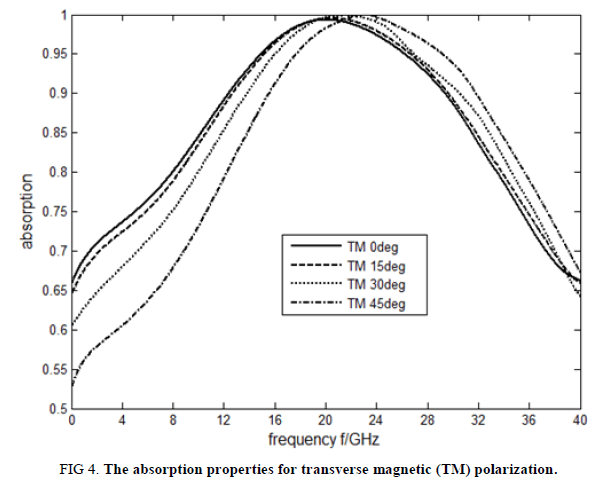Original Article
, Volume: 6( 2)Design of A Wide-angleï¼ÂBroadband and Polarization Insensitivity Metamaterial Absorber
- *Correspondence:
- Song Y , School of Electronic & Optical Engineering, Nanjing University of Science and Technology, China, Tel: +86 25 8436 8622; E-Mail: ylsong@njust.edu.cn
Received: March 16, 2018; Accepted: May 22, 2018 ; Published: May 29, 2018
Citation: Yang Yi, Song Y, Fan S. Design of A Wide-angle, Broadband and Polarization Insensitivity Metamaterial Absorber. J Phys Astron. 2018; 6(2):48
Abstract
This paper proposes a metamaterial absorber based on resistive film structure.With the incident angle of the electromagnetic wave not exceeding 45°, this metamaterial absorber can achieve a perfect absorption rate higher than 99% in a frequency range of more than 3 GHz, the absorption rate higher than 90% can completely cover the Ku- and K-band, and it also has a wide-angle,broadband and polarization insensitivity absorbing performance.
Keywords
Metamaterial absorber; Resistive film structure
Introduction
Metamaterials are structural materials with extraordinary electromagnetic and optical properties obtained by artificial synthesis [1,2]. They have extremely important research values in the fields of physics such as material science, electromagnetism, optics [3] and also have extensive applications in engineering fields [4]. With the electromagnetic radiation pollution being more and more serious, the research on the metamaterial absorber that can suppress the electromagnetic radiation pollution has become a hot topic at home and abroad.
Yang proposed an absorber composed of metamaterial and magnetic material [5]. Though it realized the ultra-thin design of the absorber through electromagnetic coupling technology, two problems still existed that the absorption peak was low and the bandwidth was narrow. Li proposed a multi-frequency metamaterial absorber that can realize perfect absorptions at four frequencies [6], but it had low electromagnetic wave absorptions for other frequencies.
In this paper, a multi-dielectric-layer metamaterial absorber based on dendritic resistive film is proposed. The absorber can realize a perfect absorption of electromagnetic waves on a specific frequency band, and has absorption performances of wide-angle, broadband and polarization insensitivity.
Material and Methods
Design of the metamaterial absorber
In general, electromagnetic wave absorption is a process of waves being converted into heat energy, which requires the reflectivity and transmissivity of electromagnetic waves as small as possible. The ideal wave-absorbing material must satisfy two conditions: (1) the impedance of the material’s surface matches with the free space to reduce the reflection of the electromagnetic wave; (2) the energy of electromagnetic wave entering the material is consumed as much as possible. To a large extent, the performance of metamaterial absorbers depends on its geometry, size, arrangement, etc. Therefore, by designing the above parameters, flexible control of the metamaterial's equivalent electromagnetic parameters can be realized, which can satisfy the needs for high and broadband absorption in applications [7-9].
In this paper, a multi-dielectric-layer metamaterial absorber based on dendirtic resistive film is proposed, having the characteristics of a high absorption rate, broad working bandwidth, and an absorption stability to incident electromagnetic wave. The structural unit consists a dendritic resistance film structure, a dielectric substrate and a bottom resistive film backplane. The dielectric substrate is composed of four layers, including two PET layers, one PMMA layer and one porous foam layer. The unit structure is shown in FIG. 1.
Figure 1: (a) Schematic structure of the designed metamaterial absorber (b) The front and (c) oblique view of the unit cell.
The unit structure sizes are as follows: the unit length is p = 8 mm p = 8mm, the thickness of resistance film is h1=0.2 mm, the square resistance value is R= 100Ω. The dielectric constant of the PET layer is εr=3.0, the loss angle tangent td= 0.06, and the thickness is h2=0.175 mm. The dielectric constant of the PMMA layer is εr=2.25, the loss angle tangent is td= 0.001, and the thickness is h3= 1.3 mm. The dielectric constant of the PET layer is εr=3.0,, the loss angle tangent is td= 0.06, and the thickness is h2= 0.175 mm. The dielectric constant of the porous foam layer is εr=1.05, the loss angle tangent is td= 0.005, and the thickness is h4= 0.5 mm. The trunk length of the dendritic resistance film structure is r1= 7 mm, its width is w1= 0.6 mm,the longest side of the lateral branch is r2= 1.65 mm, its width is w2= 0.4 mm. The distance between the adjacent branches is d1= 2.4 mm, the angle between the lateral branch and the vertical direction is deg= 60°, the shortest distance between the lateral branch and the top of the trunk is d2= 0.67 mm.
Simulation and analysis of the proposed absorber
Using CST Microwave Studio's frequency-domain solver, we can obtain the S parameters to calculate the absorption of this absorber. The absorption rate of this unit is shown in FIG. 2 as the electromagnetic wave is incident vertically.
It can be seen in FIG. 2 that when the electromagnetic wave is incident vertically, the absorption rate of this absorber reaches a peak of 99.3% at 20.04 GHz , the frequency band with the absorption rate higher than 99% is 18.56 GHz-21.56 GHz, the relative bandwidth is about 10.0%; the frequency band with the absorption rate higher than 90% is 12.21 GHz- 29.32 GHz, the relative bandwidth is about 84.8%.
On the basis of vertical incidence, we further study the absorption of oblique incident electromagnetic waves. For TE wave and TM wave with different incident angles, the absorption curves are shown in FIG. 3 and FIG. 4.
It can be seen from FIG. 3 and FIG. 4. that the proposed absorber has the characteristic of polarization insensitivity, and in the range of the incident angle from 0° to 45°, the peak of the absorption rate to TE wave and TM wave can exceed 99% . When the incident angles are 0°, 15°, 30°and 45°, the bandwidths of the absorption rate exceeding 99% are 3.04 GHz, 3.80 GHz, 5.04 GHz and 5.14 GHz; The relative bandwidths of the absorption rate exceeding 90% are 84.8%, 83.0%, 78.2% and 70.0%.
Conclusion
In this paper, by using the scattering characteristics of different dielectric layers, a multi-dielectric-layer metamaterial absorber based on dendritic resistance film structure is proposed. The simulation results show that when the incident angles do not exceed 45, the bandwidths of the absorption rate over 99% are all more than 3GHz, and the bandwidths of absorption rate over 90% are more than 70.0%. Therefore, the proposed metamaterial absorber has the characteristics of wide-angle, broadband, polarization insensitivity, and perfect wave absorption.
Acknowledgments
This work was supported by the National Natural Science Foundation of China (61571229).
References
- Watts CM, Liu X, Padilla WJ. Metamaterial Electromagnetic Wave Absorbers. Advanced Materials. 2012; 24:98-120.
- Cai WS, Shalaev VM. Optical Metamaterials: Fundamentals and Applications. New York: Springer-Verlag.2010.
- LEE YS. Principles of Terahertz Science and Technology. New York: Springer-Verlag. 2009.
- Ostmann TK, Nagatsuma T. a review on terahertz communications research. J Infrared Milli Terahz Waves. 2011;32:143-71.
- YANG JX. Design of a p-band absorber based on metamaterial and magnetic material. The Chinese Institute of Electronics. 2017 national antenna annual conference paper. The Chinese Institute of Electronics. 2017:3.
- Li SJ. Research on the design of multiband perfect metamaterial absorber. The Chinese Institute of Electronics.2017 national antenna annual conference paper. The Chinese Institute of Electronics. 2017:3.
- Sijia Li. Wideband, thin and polarization insensitive perfect absorber based the double octagonal rings metamaterials and lumped resistances. J Appl Phys. 2014;116:043710.
- Fan Y, Cheng YZ, Nie Y, et al. An ultrathin wide-band planar metamaterial absorber based on a fractal frequency selective surface and resistive film. Chin Phys B. 2013;88:570-5.
- Zhao J C, Cheng YZ. Ultrabroad band microwave metamaterial absorber based on electric SRR loaded with lumped resistors. J Electron Mater. 2016;45:5033-9.





